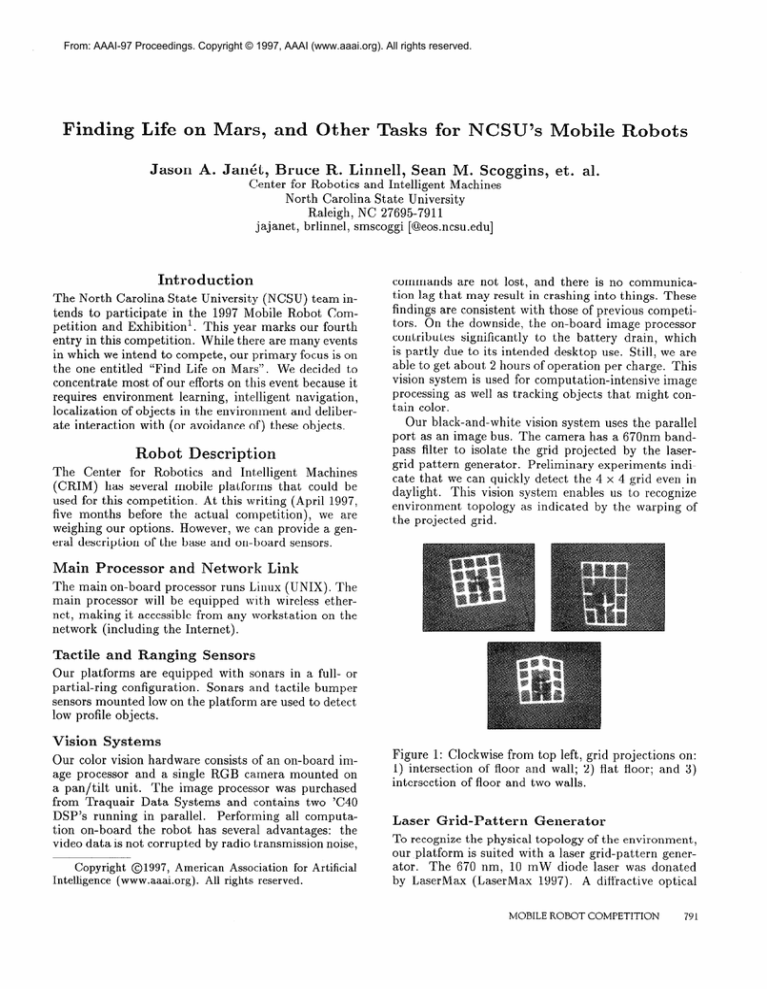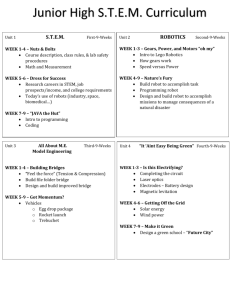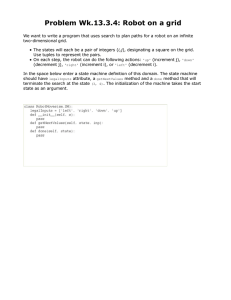
From: AAAI-97 Proceedings. Copyright © 1997, AAAI (www.aaai.org). All rights reserved.
Finding Life on Mars, and other Tasks for NCSU’s
Jason A. Jan&t, Bruce R. Linnell,
Mobile
Sean M. Scoggins,
et. al.
Center
for Robotics and Intelligent Machines
North Carolina State University
Raleigh, NC 27695-7911
jajanet,
brlinnel, smscoggi [@eos.ncsu.edu]
Introduction
The North Carolina State University (NCSU) team intends to participate
in the 1997 Mobile Robot Competition and Exhibition ‘. This year marks our fourth
entry in this competition.
While there are many events
in which we intend to compete, our primary focus is on
the one entitled “Find Life on Mars”. We decided to
concentrate
most of our efforts on this event because it
requires environment
learning, intelligent navigation,
localization of objects in the environment
and deliberate interaction
with (or avoidance of) these objects.
Robot
Description
The Center for Robotics
and Intelligent
Machines
(CRIM)
has several mobile platforms
that could be
used for this competition.
At this writing (April 1997,
five months before the actual competition),
we are
weighing our options. However, we can provide a general description of the base and on-board sensors.
Main
Processor
and Network
commands are not lost, and there is no communication lag that may result in crashing into things. These
findings are consistent with those of previous competitors. On the downside, the on-board image processor
contributes
significantly
to the battery
drain, which
is partly due to its intended desktop use. Still, we are
able to get about 2 hours of operation per charge. This
vision system is used for computation-intensive
image
processing as well as tracking objects that might cont ain color.
Our black-and-white
vision system uses the parallel
port as an image bus. The camera has a 670nm bandpass filter to isolate the grid projected
by the lasergrid pattern generator.
Preliminary
experiments
indicate that we can quickly detect the 4 x 4 grid even in
daylight.
This vision system enables us to recognize
environment
topology as indicated by the warping of
the projected grid.
Link
The main on-board processor runs Linux (UNIX). The
main processor will be equipped with wireless ethernet, making it accessible from any workstation on the
network (including the Internet).
Tactile
and Ranging
Sensors
Our platforms are equipped with sonars in a full- or
partial-ring
configuration.
Sonars a.nd tactile bumper
sensors mounted low on the platform are used to detect
low profile objects.
Vision
Systems
Our color vision hardware consists of an on-board image processor and a single RGB camera mounted on
a pan/tilt unit. The image processor was purchased
from Traquair
Data Systems and contains two ‘C40
DSP’s running in parallel.
Performing
all computation on-board the robot has several advantages:
the
video data is not corrupted by radio transmission noise,
Copyright
01997,
American
Association
for Artificial
Intelligence
(www.aaai.org).
All rights reserved.
Figure 1: Clockwise from top left, grid projections
on:
1) intersection
of floor and wall; 2) flat floor; and 3)
intersection
of floor and two walls.
Laser
Grid-Pattern
Generator
To recognize the physical topology of the environment,
our platform is suited with a laser grid-pattern
generator. The 670 nm, 10 mW diode laser was donated
by LaserMax
(LaserMax
1997).
A diffractive optical
MOBILE ROBOT COMPETITION
791
element at the output of the laser, generates a 4 x 4
grid at a 16 deg full-angle spread. Fast visual isolation
of the grid is achieved with the black-and-white
vision
system mentioned above. The projected grid is a regular geometric grid with known size. By determining
the amount of warpage in the reflected grid pattern,
shape information can be extracted about the surface
on which the grid is projected.
4-DOF
Arm
To deliberately move objects in the environment, our
platform is equipped with a 4 degree-of-freedom
(DOF)
arm. Due to the rapid prototyping capabilities of the
CRIM, this arm was quickly designed and built in
preparation for the 1996 AAAI robotics competition.
Since that time, some refinements have been made to
enable faster movement of the end-effector, reduce the
arm’s physical size, strengthen certain gear-trains and
reduce the amount of real estate consumed by the electronics. The arm can reach approximately
60 cm,
Perception/Manipulation
To detect, track, avoid and/or manipulate objects
the environment we can employ the following:
in
Perception:
The color vision system on the robot
and a color-histogramming
technique can be used to
recognize and track colored objects (LeGrand 1996).
Another alternative would be to use the HEC neural network for for adaptively tracking multi-colored
objects In addition, the laser grid pattern projected
in front of the robot will be analyzed by the blackand-white vision system to extract local topological
information about the environment within the arm’s
work envelope.
Manipulation:
With our 4-DOF arm we can retrieve objects up to 18 cm wide. The laser grid-based
vision system will provide information with respect
to the layout of objects immediately in front of the
robot.
This information
can be used to construct
safe and effective gripper trajectories for grasping.
In addition, local shape information from the vision
system can be used to optimally grasp objects of
various shapes.
References
Janet, J. A.; Luo, R. C.; Kay, M. G. 1997a Autonomous Mobile Robot Global Motion Planning and
Geometric Beacon Collection Using Traversability Vectors.
IEEE Trans.
on Robotics and Automation,
13(1):132-140.
Figure 2: Sequence of robot approaching,
lifting a tennis ball with 4-DOF arm.
grasping and
Methodology
We intend to build on the hardware and software we
used in the 1995 and 1996 Mobile Robot Competition.
The basic approaches under consideration are summarized in the following sections.
Navigation
The navigation
Architecture
architecture
consists of the following:
High-level planning:
Global motion planning can
be done using the Essential Visibility Graph which
is based on traversability vectors (Janet 1997a). We
can also plan motion using a topological map built
with a hyper-ellipsoid
clustering (HEC) neural network (Janet 1997c, Janet 1997d).
Place recognition:
We can use the HEC neural
network (Janet 1997c, Janet 1997d) or the RegionFeature Neural Network (Janet 1997b) to estimate
the location of the robot in the topological map from
dead-reckoning,
sonars and vision.
792
MOBILE ROBOT COMPETITION
Janet, J. A.;Gutierrez,
R.; Chase, T. A.;White,
M.
W.; Sutton, J. C. 1997b. Autonomous
Mobile Robot
Global Self-Localization
Using Kohonen and RegionFeature Neural Networks, Journal of Robotic Systems:
Special Issue on Mobile Robots. 14(4):132-140.
Janet, J. A.; Scoggins, S. M.; White, M. W.; Sutton,
J. C.; Grant, E.; Snyder, W. E. 1997c. Self-Organizing
Geometric Certainty Maps:
A Compact
and Multifunctional Approach to Map Building, Place Recognition and Motion Planning,
In Proc of IEEE Int’l
Conf on Robotics and Automation,
Albuquerque,
NM.
April, 1997.
Janet, J. A.; Scoggins, S. M.; White, M. W.; Sutton,
J. C.; Grant, E.; Snyder, W. E. 1997d. Using a HyperEllipsoid Clustering Kohonen for Autonomous
Mobile
Robot Map Building, Place Recognition
and Motion
Planning, In Proc of IEEE Int’l Conf on Neural Networks, Houston, TX. June, 1997.
LaserMax, Incorporated.,
3495 Winton Place, Building
B, Rochester, NY 14623. (716) 272-5420.
LeGrand, R. M.; Luo, R. C. 1996. Position Estimation of Selected Targets. In Proc of IEEE Int’l Conf
on Robotics and Automation,
Minneapolis, MN. April,
1996.




